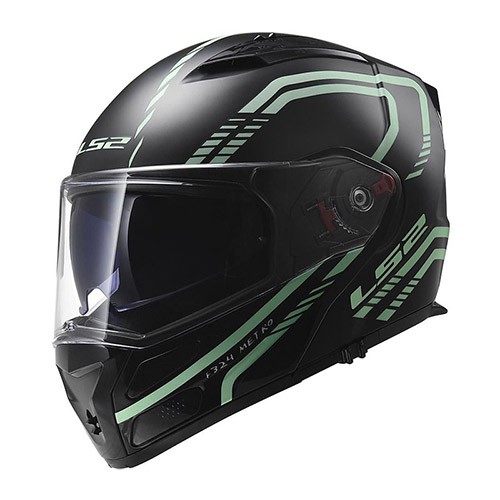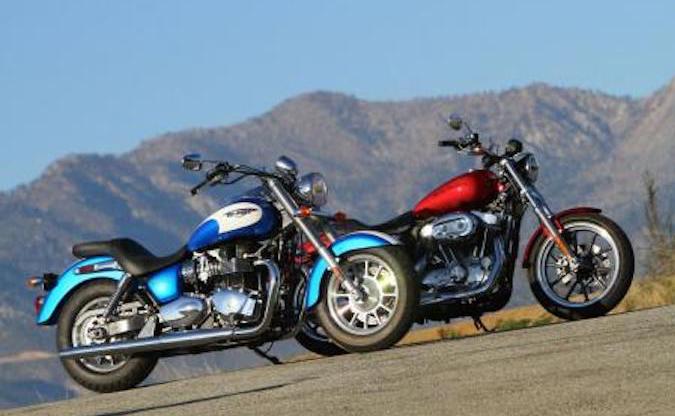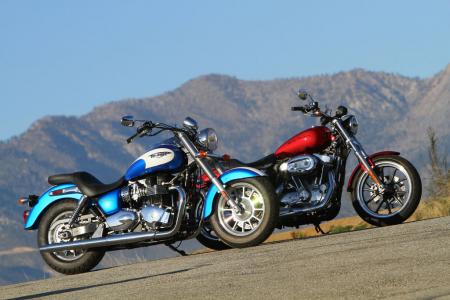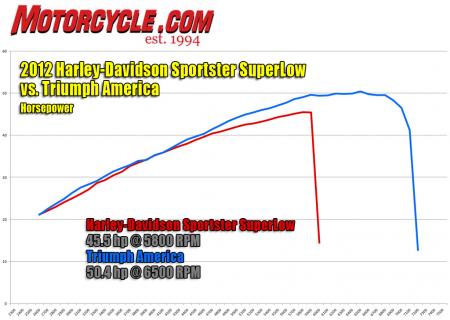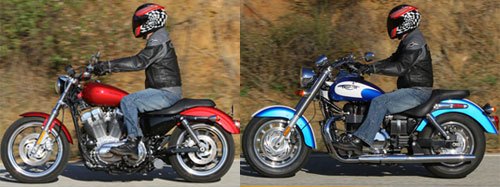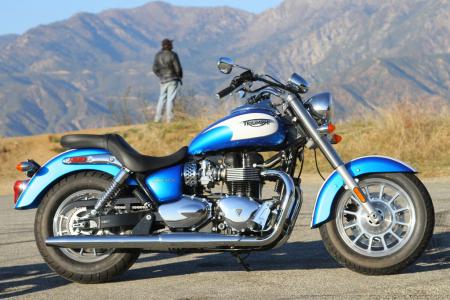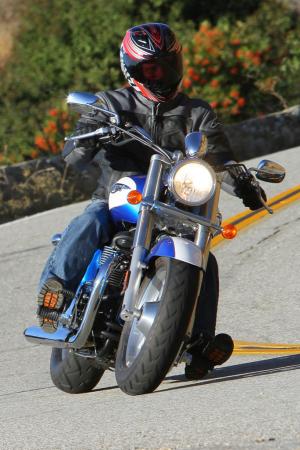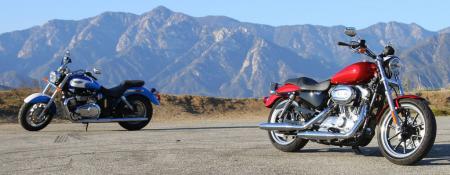
Ten years ago, the www and Motorcycle.com had finally established a bridgehead, and were attacking on all moto fronts, including the video one. Shame about the cheesy music, but that’s how copyright law works. If you’re not feeling Harley’s new Sportsters, perhaps remembering the SuperLow will stimulate your affection glands – though our main complaint ten years ago was, wait for it – two inches of rear-wheel travel.
According to a 2008 NYTimes.com blog article, the average cost of a new bike in 2007 was in excess of $12,000. Considering the world economic climate of the past few years, there’s not much reason to think bikes have become any less expensive. But all is not lost.If you’re eager to have a user-friendly ride – specifically in the ever-popular cruiser category – that won’t break the bank and yet still offers reputable performance, quality craftsmanship, appealing styling and is welcoming of new and/or returning riders, then gaze upon the Harley-Davidson Sportster SuperLow and Triumph America.
Both motorcycles provide comfortable riding positions. The Harley is better suited to riders with short inseams, which might include plenty of female riders looking for that first motorcycle. The America’s layout is such that it accommodates a wider range of statures, including folks standing six-feet-plus. But that’s not to imply the America is too big for petite frames, as its seat height is only 0.3 inch taller than the SuperLow’s 26.8-inch saddle.
Complementing friendly ergos is ease-of-use. Each bike’s overall performance reveals that Harley and Triumph have imbued these comparatively basic motorcycles with appreciable levels of refinement learned from decades of building bikes: everything, from braking to throttle/fueling response to handling to shifting, operates reliably, allowing the rider to focus on and enjoy the ride.
|
Harley-Davidson’s Sportster SuperLow and Triumph’s America retail in the $8000 price range. They offer lots of name-brand value to the consumer in the form of quality construction, good performance and friendly ergonomics. |
Perhaps most appealing, though, is that the SuperLow and America bring their respective qualities to the table with bargain MSRPs: The Harley starts at $7999 in Vivid Black, with color models a few hundred dollars more, while the Triumph rings in between $8299 to $8599 depending on color choice.
Take that, high-average-price-of-a-new-motorcycle statistics!
|
The SuperLow and America fit the bill as entry-level cruisers, but experienced riders should also find them enjoyable. |
Besides sharing low price-points, these cruisers are also similar in that each has a twin-cylinder engine in the 800cc range; both are fuel injected, have five-speed transmissions, low seat heights and a single (rather than dual) disc front brake. Yet for these similarities, and others, the SuperLow and America are markedly different in numerous ways. Let’s look at some of the commonalities and disparities ‘tween the two, starting with their powerplants.
Two peas from different pods
Other than by its own name, a Harley is most readily known by its engine: a 45-degree, air-cooled V-Twin in a displacement ranging from 883cc to 110c.i. (1802cc) depending on the model. As a Sportster model, the SuperLow bears the admirable burden of continuing the long-running Harley heritage that sees all Sporties powered by either an 883cc or 1200cc Twin. As a descendant of the 883L, the SuperLow is supplied with the humble but stout 883cc V-Twin.
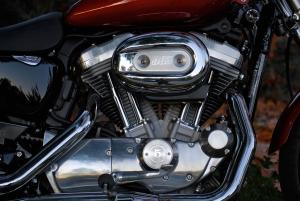 The SuperLow’s 883cc air-cooled, fuel-injected V-Twin is a well-known engine.
The SuperLow’s 883cc air-cooled, fuel-injected V-Twin is a well-known engine.
After decades of successfully imposing itself upon the knowledge base of the modern motorcyclist, the Harley engine is a known quantity. It provides a loping quality during idle, emits a low rumbling thunder from its exhaust and, for its displacement, generates substantial torque right off idle.
Following the burst of acceleration (torque) nearly the instant the clutch lever is released, the SL’s power otherwise builds gradually but deliberately, which is to say the engine makes its power in a very predictable manner. And predictability is good in any scenario, but all the more so in motorcycling, especially in the SuperLow’s case when it’s highly probable the person accessing the engine’s power is a new-ish rider. A rider is empowered with confidence whenever power delivery can accurately be anticipated.
However, as noted above, as well as in the SuperLow’s single-bike review, the smack of torque the engine delivers just as the clutch lever is released may catch some riders unawares. If we were to give the Harley’s engine a demerit, it would come in the form of this abrupt power delivery at low rpm. Otherwise, the 883, she’s a classic gem of a V-Twin.
The Harley’s 45.5 peak horsepower falls about 10% short of the Triumph’s 50-ish horsepower. The amount of twisting force (torque) each bike produces is essentially a dead heat, with less than 1.0 ft-lb and only a couple hundred rpm between their peak torque results.
|
The Harley’s engine is strong right out of the gate, keeping pace with the Triumph for several thousand rpm. However, the design of the America’s engine allows it make more power and maintain its additional power long after the SuperLow has peaked. |
To most riders considering these motorcycles as potential modes of transport, the difference between those figures is merely a statistical nuance. But for the right rider – perhaps a rider with a more refined sense of what he or she desires from an engine’s character – what may come across as appealing from the America’s engine architecture is how it makes its power.
The America’s 865cc parallel–Twin is a less familiar platform in the cruiser world where V-Twins still rule the day. However, the Triumph’s engine design allows it to “spin up,” or rev, quicker and longer than does the Harley’s V-Twin. And while each engine’s linear power and torque curves are closely matched for several thousand rpm in the beginning, the Triumph’s engine continues to build on its power, eventually outpacing and outlasting the SuperLow long after it hits its stride.
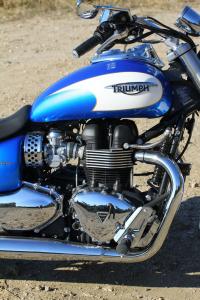 When it comes to cruisers the overwhelming choice of engine is a V-Twin. The Triumph’s parallel-Twin is a refreshing break from that mold, and its performance is on par (or better!) with V-Twins in its class.
When it comes to cruisers the overwhelming choice of engine is a V-Twin. The Triumph’s parallel-Twin is a refreshing break from that mold, and its performance is on par (or better!) with V-Twins in its class.
Ultimately the Triumph has the advantage, at least on paper, but both bikes have strong acceleration out of the gate, like when pulling away from a stop. Each bike enjoys the benefit of excellent throttle response provided by trouble-free fuel injection, and each has a slick-shifting gearbox.
If you fancy a revvy engine, perhaps because some of your buddies’ racy sportbikes have influenced your tastes, then the Triumph might hold greater sway with you. Furthermore, the America is one smooth operator. The British Twin is virtually silent and vibration-free compared to the Harley’s shaking and rumbling engine. On the other hand, if you’re less interested in peak power figures than you are how effortlessly the bike’s engine can launch from a dead stop and keep the bike churning ahead, even in top gear, then the SuperLow’s iconic V-Twin, with a classic rolling-thunder exhaust note and genuine visceral character, is your ticket.
While a motorcycle’s engine is a leading aspect that draws in riders, it isn’t the single most important defining quality of a bike, especially within the cruiser realm where other qualities carry considerable weight in the mind of the rider. Let’s move on to other areas of consideration that separate these class-comparable rides.
2012 Harley-Davidson Sportster SuperLow $7999 – $8499
Harley-Davidson doesn’t specifically promote the SuperLow as an ideal motorcycle for new riders and/or women. But take into account its 26.8-inch seat height as part of its compact ergos, and this Harley’s dimensions are integral to its overall appeal for a raft of riders that find larger bikes intimidating.
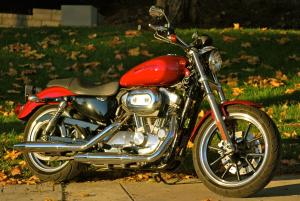 The SuperLow’s ergonomic layout makes it a natural choice for riders who are uneasy with piloting a larger machine.
The SuperLow’s ergonomic layout makes it a natural choice for riders who are uneasy with piloting a larger machine.
With that low seat height, a rider can easily straddle the bike, and in almost any case comfortably put both boots flat on the ground – this quality alone can do wonders for instilling in riders confidence they can physically manage this motorcycle’s 563-pound running-order weight. Not immediately apparent about the SuperLow’s seat height is what partially contributes to bringing the saddle as low as it is: limited suspension travel.
Two inches and some change is all the dual coil-over shocks have to move up and down to absorb whatever you and the road throw at them. On roads in good repair the Harley provides decent ride quality, but hit a large enough expansion joint or pothole and you’ll immediately use up those two inches of travel. When this occurs there’s nothing else for the impact of the bump to do except keep moving up until it reaches the rider. On a street or stretch of freeway in bad shape you might find the SuperLow rides on the rough side.
The rest of the layout for rider controls includes footpegs placed near the center of the bike, in the mid-mount position, and an easy reach to the one-piece handlebar.
|
Note the difference in where the rider’s foot is placed on each bike. The SuperLow’s mid-mount controls put the rider in a neutral riding position, while the America’s seating position is closer to the traditional, more relaxed cruiser layout. |
Taken as a whole, the ergonomic set up makes for a snug fit if you’re around 5-feet-10-inches. And if you’re 6-feet and above you’ll probably find the SuperLow is simply too cramped an environment for extended rides. For anyone below that stature threshold, the SL provides a cozy cockpit. A caveat worth noting is how easily a rider’s elbows can obscure the mirrors’ rearward view. I found this an unusual experience – it’s often problematic on sportbikes but not so much for cruisers.
With a 59.3-inch wheelbase (4.3 inches shorter than the Triumph) the SuperLow is a spry lil’ handler. Steering effort is light, and the Harley transitions easily between corners. Nevertheless, the just-barely-there rear suspension travel rears its head once again. As a result of the SuperLow’s low-ridin’ ways, the bike is woefully limited to how far it can lean into a turn before the footpegs or lower exhaust mounts grind themselves into the asphalt. This isn’t necessarily a deal-breaker, but you’ll either have to accept this reality soon and learn how live with it, or find that it’s annoyingly restrictive to sporty riding.
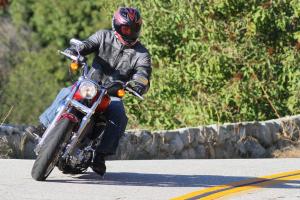 The Harley is an entertaining ride in just about any situation, but limited lean angle clearance means hard parts are often dragged in the corners.
The Harley is an entertaining ride in just about any situation, but limited lean angle clearance means hard parts are often dragged in the corners.
The dual-piston front caliper found on many Harley cruisers is also what the SuperLow uses to reel in speed. Lots of previous experience with this common Harley brake set told me not to anticipate anything beyond adequate stopping power. This time out, though, I was impressed with how effortlessly the simple set-up halted the Harley’s forward progress – just a couple fingers squeezing the brake lever was all that was needed.
Instrumentation consists of a speedometer with an LCD inlay displaying mileage, tripmeter and clock, with an array of warning lights in the speedo mount – it’s a simple package but works well with the SuperLow’s clean, unembellished styling.
By virtue of the SuperLow’s borderline-diminutive dimensions, it’s not the motorcycle for everyone. But for those riders looking for a modestly sized cruiser with full-size performance, the SuperLow should find its way on their short list. Icing the cake is the ability to park the legendary Harley-Davidson brand in your garage for a mere $8000.
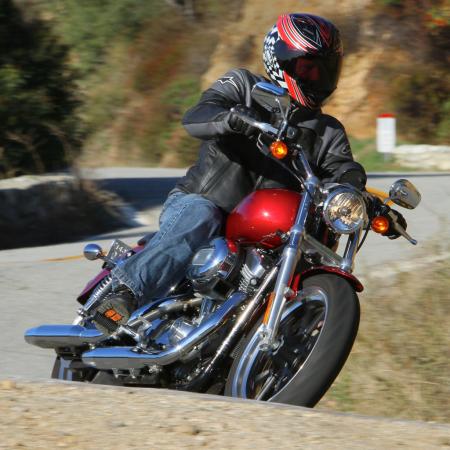 |
2012 Triumph America $8299 – $8599
The SuperLow’s compact dimensions open doors to the cruiser world for riders that, well, also have their own compact dimensions and are on a limited budget. The America, on the other hand, is a reg’lar-size machine. But it also comes with a price that won’t induce sticker shock, making it an excellent alternative for cost-conscious riders that don’t require a somewhat-specialized rider triangle.
I was surprised at the stark contrast between each bike’s rider layout when I had my first opportunity to switch immediately from the SuperLow to the America
|
The America is welcome change of pace from the motorcycles typically found in this segment of the cruiser genre. |
You’ll sit mostly upright in the Triumph’s large, wide saddle (the passenger seat is also roomy), and the sweeping pull-back handlebar makes for a natural, easy reach. In contrast to the Harley’s mid-mount foot controls, the America’s footpegs are mounted forward, but close enough to complete its relaxed rider triangle. Despite the considerably roomier cockpit, you never feel like you’re slouching in the seat that’s 27.1 inches above the tarmac.
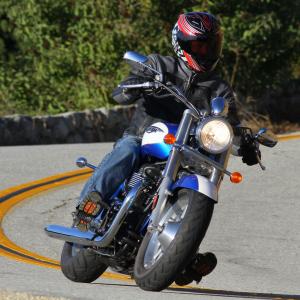 Compared to the compact SuperLow, the America will fit a wider range of rider statures. Although it has a similar displacement to the Harley, the America is otherwise a full-size cruiser.
Compared to the compact SuperLow, the America will fit a wider range of rider statures. Although it has a similar displacement to the Harley, the America is otherwise a full-size cruiser.
Furthermore, Triumph achieved this low seat height without chopping down rear suspension travel: the America’s dual coil-over shocks provide 3.7 inches of travel – effectively double what the SuperLow provides out back. This additional travel pays dividends in the form of a suppler, forgiving ride, especially when you encounter crummy pavement.
The America’s 63.6-inch wheelbase is long compared to the Harley’s wheelbase, and so I half expected this to surface in the form of lazy steering, but once again the Triumph took me by surprise. The extra inches between the America’s wheels benefited the bike by keeping the chassis stable, yet the bike’s steering geometry also provided light-action handling allowing me to dice around canyon corners without feeling like I was exerting excessive energy just to flick the Triumph from side to side.
When a rider will notice the America’s longer wheelbase is during tight radius U-turns and the like. The Harley can turn much tighter circles than the America. Smaller, shorter riders take note: the SuperLow is nimbler at lower speeds.
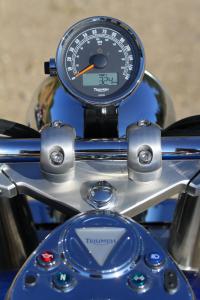 The Triumph and Harley both use minimal instrumentation.
The Triumph and Harley both use minimal instrumentation.
A single, two-piston front caliper and 310mm rotor are what the Triumph uses to slow down from the front-end, but the package is more than adequate. While the America’s front brake performance isn’t heaps better than the Harley’s, the Triumph nevertheless does offer a crisper, more authoritative feel at the lever. And the America has the useful feature of four-position adjustable clutch and brake levers; the Harley does not.
Instrumentation is as simple on the America as it is on the SuperLow. A speedo with LCD inlay sits above the Triumph’s big, chrome headlight, but rather than incorporate warning lamps in the speedo mount Triumph instead placed them in a gleaming chrome tank console that also encompasses the non-locking fuel cap (the SL’s cap also doesn’t lock).
We appreciated the Triumph’s rich two-tone paint and liquid-metal-like luster of its numerous chrome components, yet as noted in the America’s single-bike review, I couldn’t help but draw comparisons to Japanese cruiser styling, especially with little offenses like the cheap-looking stamped steel speedo mount and less than ideal routing of the clutch cable. However, I can over look these styling peccadilloes as minor tradeoffs for mirrors that are much more useful than the Harley’s.
The Triumph America is in some ways a typical Harley-clone, but its vertical-Twin powerplant is a welcome departure from the ubiquity of V-Twin-powered cruisers. Building on the America’s positives are its full-size rider ergos, excellent handling and a spirited engine.
|
The America will also drag a footpeg, but with more suspension travel you won’t touch hard parts in a corner nearly as early as on the SuperLow. |
And The Winner Is…
With MSRPs so close in proximity, the Harley and Triumph’s costs become a non-issue. A prospective buyer is then left to decide which motorcycle will better suit specific needs and desires.
I genuinely found riding the SuperLow a gas. Despite occasionally feeling like the SL’s cramped quarters would eventually grow old if I owned it, I still couldn’t deny the care and quality that Harley invested in this model, from its clean, simple styling to the undeniable “American V-Twin” character it possess. It is, after all, the original.
|
Like with so many modern motorcycles, the Triumph America and Harley-Davidson SuperLow do more things right than wrong. But with the Triumph’s less restrictive ergonomics we think it makes a better choice for more riders. However, for riders that find the SuperLow a perfect fit, this Harley is an ideal choice. Either way, with price tags in the low to mid $8000 price range, it’s hard to argue against picking either bike. |
But my pragmatic side says the Triumph America just makes more sense for a greater cross section of riders because of its accommodating fit, big bike looks and feel, good overall performance and unique engine. I felt like I could live more comfortably day in and day out with the America than I could the SuperLow. But if you’re a rider that finds the Harley is an ideal fit, then you’ve found your cruiser.
In either case, with such low price tags for these quality motorcycles from venerable motorcycle brands, either choice is the right choice.
| By the Numbers | ||||
| Harley-Davidson Sportster SuperLow | Triumph America | |||
| Engine Type | Air-Cooled V-Twin | Air-cooled parallel-Twin | ||
| Displacement | 883cc | 865cc | ||
| Bore & Stroke | 76.2 x 96.8mm | 90.0 x 68.0mm | ||
| Compression | 8.9:1 | N/A | ||
| HP (BHP or Rear Wheel) | 45.5 | 50.4 | ||
| Torque | 46.3 | 47.1 | ||
| Frame | Steel tube | Steel tube | ||
| Wheelbase | 59.3 in | 63.6 in | ||
| Rake/Trail | 31.1/5.7 | 33.0/5.6 | ||
| Front Suspension | 39mm Showa Fork | 41mm Kayaba | ||
| Rear Suspension | Dual Coil-Over | Dual Coil-Over | ||
| Front/Rear Tires | 120/70 x 18 & 150/60 x 17 | 130/90 x 16 & 170/80 x 15 | ||
| Front Brakes | Single, dual piston | Single, dual piston | ||
| Rear Brakes | Single-piston | Single, dual piston | ||
| Seat Height | 26.8 in. | 27.1 in. | ||
| Wet Weight | 563 lbs | 550 lbs | ||
| Fuel Capacity | 4.5 gal | 5.1 gal | ||
Related Reading
2010 Honda Shadow RS vs. 2012 Harley-Davidson 883 Low
McQueen v. Knievel Road Test
2012 Harley-Davidson Models Updates
2012 Honda Fury vs. 2011 Yamaha Star Stryker
2011 World Cruiser Shootout
2006 Light-Middleweight Cruiser Comparison
